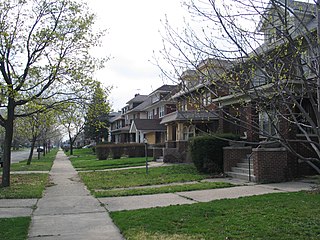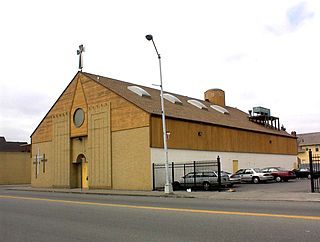
Detroit is the largest city in the U.S. state of Michigan. It is also the largest U.S. city on the United States–Canada border, and the seat of government of Wayne County. The city of Detroit had a population of 639,111 at the 2020 census, making it the 27th-most populous city in the United States. The metropolitan area, known as Metro Detroit, is home to 4.3 million people, making it the second-largest in the Midwest after the Chicago metropolitan area, and 14th-largest in the United States. Regarded as a major cultural center, Detroit is known for its contributions to music and as a repository for art, architecture and design, along with its historical automotive background.
Warrendale is a community in far western Detroit, Michigan. It is bordered by Greenfield East Road, Joy Road, and the Detroit city limits. Warrendale neighbors Dearborn on two sides and Dearborn Heights on another side.

Hmong Americans are Americans of Hmong ancestry. Most Hmong Americans consist of those that fled to the United States as refugees in the late 1970s due to their cooperation with the United States' Central Intelligence Agency operatives in northern Laos during the Vietnam War, and their descendants. Over half of the Hmong population from Laos left the country, or attempted to leave, in 1975, at the culmination of the war. At the time, the Pathet Lao launched an aggressive campaign to capture or kill Hmong soldiers and families who aided the CIA. Thousands of Hmong were evacuated or escaped on their own to Hmong refugee camps in Thailand. About 90% of those who made it to refugee camps in Thailand were ultimately resettled in the United States. The rest, about 8 to 10%, resettled in countries including Canada, France, the Netherlands, and Australia. According to the 2019 American Community Survey by the US Census Bureau, the population count for Hmong Americans was 327,000.

Brightmoor is a roughly 4-square-mile (10 km2) neighborhood in Detroit, Michigan, near the northwest border of the city. Brightmoor is defined by the Brightmoor Alliance as being bordered by Puritan Road to the north, the CSX railway to the south, Evergreen Road to the east, and Outer Drive West, Dacosta Street, and Telegraph Road to the west. However, the demographics given here for the neighborhood are the city's statistical Master Plan Neighborhood area, which consists of eight census tracts that includes some areas outside of the Alliance's boundaries, but does not include some areas within its boundaries.
Conant Gardens is a historically Black neighborhood in northeast Detroit, Michigan. The neighborhood was once the most exclusive Black neighborhood in that city, and residents of Conant Gardens comprised the most highly educated Black enclave in Detroit.
Graem Whyte is an American sculptor and gallerist. White was born and raised in metropolitan Detroit and now lives in Hamtramck, Michigan.
Glenshire is a subdivision in the Brays Oaks district in Houston, Texas. The community is in proximity to Fort Bend County. In 1989 the community had about 5,000 residents. R.A. Dyer and Claire Osborn of the Houston Chronicle said in 1989 that Glenshire was "a middle-class residential area".

The Boston–Edison Historic District is a historic neighborhood located in the geographic center of Detroit, Michigan. It consists of over 900 homes built on four east/west streets: West Boston Boulevard, Chicago Boulevard, Longfellow Avenue, and Edison Avenue, stretching from Woodward Avenue on the east to Linwood Avenue on the west. It is one of the largest residential historic districts in the nation. It is surrounded by Sacred Heart Major Seminary to the west, the Arden Park-East Boston Historic District and the Cathedral of the Most Blessed Sacrament to the east, and the Atkinson Avenue Historic District to the south. The district was designated a Michigan State Historic Site in 1973 and listed on the National Register of Historic Places in 1975.

Gran Torino is a 2008 American drama film directed and produced by Clint Eastwood, who also starred in the film. The film co-stars Christopher Carley, Bee Vang, and Ahney Her. This was Eastwood's first starring role since 2004's Million Dollar Baby. The film features a large Hmong American cast, as well as one of Eastwood's younger sons, Scott. Eastwood's oldest son, Kyle, provided the score. Set in Highland Park, Michigan, it is the first mainstream American film to feature Hmong Americans. Many Lao Hmong war refugees resettled in the U.S. following the establishment of a socialist government in Laos in 1975.

Atkinson Avenue is an east/west street located in the geographic heart of the city of Detroit, Michigan. The historic district had 225 houses in 2010.

The Palmer Woods Historic District is a residential historic district bounded by Seven Mile Road, Woodward Avenue, and Strathcona Drive in Detroit, Michigan. There are approximately 295 homes in the 188-acre (0.76 km2) district, which is between the City of Highland Park in Wayne County and the City of Ferndale in Oakland County. It was listed on the National Register of Historic Places in 1983. The Detroit Golf Club is nearby.

Rosedale Park is a historic district located in Detroit, Michigan. It is roughly bounded by Lyndon, Outer Drive, Grand River Avenue, Southfield Freeway, Glastonbury Avenue, Lyndon Street and Westwood Drive. It was listed on the National Register of Historic Places in 2006. The Rosedale Park district has the largest number of individual properties of any district nominated to the National Register of Historic Places in Michigan, with 1533.
Sherwood Forest is an area in Detroit, Michigan, United States. The district is bounded by Seven Mile Road, Livernois, Pembroke, and Parkside. The community, with about 435 houses, consists of two subdivisions: Sherwood Forest and Sherwood Forest Manor.

Chaldean Town was a historically Chaldo-Assyrian neighborhood in Detroit located along West Seven Mile Road in a segment in between Woodward Avenue to the west and John R St. to the east. Circa 2007 the population of the district was mainly low income elderly people and recent immigrants, who were mostly made up of Chaldean Catholic Assyrians. The neighborhood was usually just a stop point for newly arrived immigrants, who then typically preferred to move to the suburbs of Detroit when they could afford to.

Springwells is a neighborhood in Southwest Detroit, near the Ford Motor Company River Rouge Plant.

Osborn High School, also known as Osborn Academy of Mathematics is a four-year high school in the Detroit Public Schools Community District (DPSCD), located in Northeast Detroit.

MorningSide is a neighborhood on the east side of Detroit, Michigan. The area is bounded by Harper Avenue and Interstate 94 on the north, Mack Avenue to the south, East Outer Drive and Whittier on the east and Alter Road and East Outer Drive to the west. The local association that shares the name MorningSide with the community is a collaboration of residents working together to take care of this area.

Boynton and Oakwood Heights are the two southernmost neighborhoods of the city of Detroit in the U.S. state of Michigan. The two neighborhoods occupy the only portions of Detroit located south of the River Rouge.
Krainz Woods is a neighborhood in Detroit, Michigan.
As of 2007 most Hmong people in the State of Michigan live in northeastern Detroit, but they have been increasingly moving to Pontiac and Warren.













